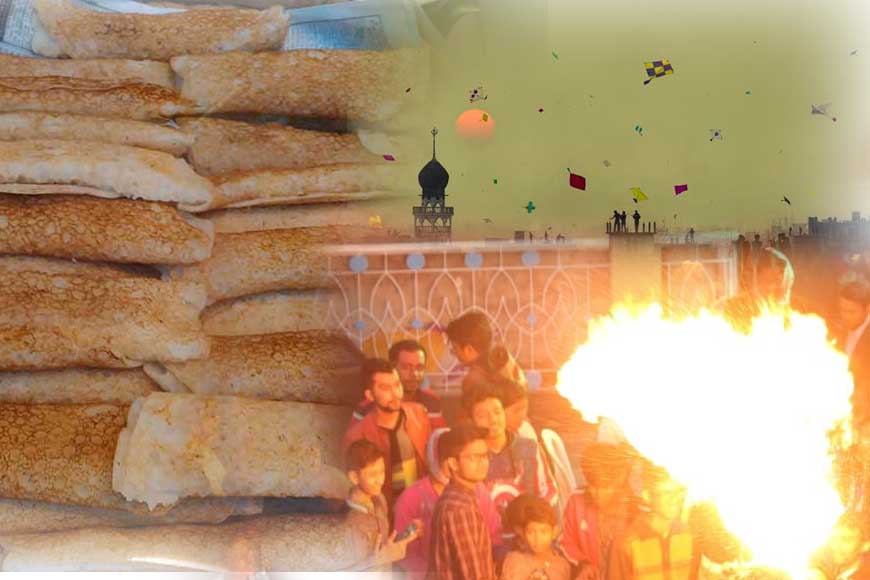Poush Sankranti Dhaka and Sylheti style!

If you happen to have descended from ancestors, who lived or still live in Bangladesh, then you must have heard stories of not just yummy pithe, but of a Poush Sankranti that is still celebrated OparBanglaa style! Ever heard of mera-merighar? Or even of Shakrain festival of Dhaka?In and around Old Dhaka, Shakrain is widely celebrated even today, when the sky bursts into colours with numerous kites fighting out a battle of threads and nerves. High on every rooftop of even in urbanized Dhaka, adrenalines flow as colourful kites fire up the brazen winter sky and then burst in celebrations of teams of youngsters and old wise grey heads alike. Poush Sankranti is undoubtedly about celebrations and fun, as the year of harvest comes to a close and a super agrarian society of Bengal, celebrates the toil and yield of its fertile soil.
Celebrations flow into the night sky, as the capital’s horizon light up in grand fireworks. In recent times, fire-spinners and flame-eaters also gather on rooftops to entertain people with their skills. When I was a child, I had often heard tales from my maternal grandparents, who had links to both Myemensingha and Sylhet, about the various rituals of Poush Sankranti that was hardly ever followed in Kolkata or any of the West Bengal districts. One particular Sylheti style of celebration that attracted my childhood senses was the ‘Mera-Merirghorjole re hoi!’
The rhyme went thus:
‘Meragelobajaro, Meri gelo koi?
Mera-Merirghorjole re hoi!’
(The ram and ewe’s home is up in flames!The ram’s out shopping and the ewe’s missing.
The ram and ewe’s home is up in flames!).
The curious me was more interested in the reasons behind such a ritual than in the actual act. But my granny would explain the fun of children surrounding the Mera Meri Ghar that would be made of bamboo sticks and cardboard boxes, the vibrant yelling chorus ringing above the dawn sky, with bursting flames giving warmth to a chilly winter. While I am unaware of the intended meaning behind this announcement of the burning down of the sheep family home, I realized after speaking to a number of friends in Assam, many of whom have a Sylheti origin, that burning the bamboo and stubbles gave the warmth on a chilly morning. Sylhet and Myemensingha being on the other side of the Garo Hills, had cold winters, unlike the coastal areas of Bangladesh.
These celebrations can still be found in parts of Assam’s Barak Valley, Tripura, and in other parts of North East India with sizeable number of migrants from East Bengal, who have settled here. In fact, a similar ritual, ‘Meji’ is also practised by the Assamese during Bhogali Bihu. Even in the hill city of Shillong, bamboo was in abundance but not straw. So, they use dried needle-like pine leaves. The structures of the houses to be burnt are single-storied, or at times the more adventurous two-storied with fancier frames.
Back in our grandparents’ days, there would be at times bitter competition between different groups and often there would be attempts by rivals to burn down the competition’s ‘Mera-Meri’ houses before the Sankranti dawn. Therefore, the entire team had to be on guard all night long.But guarding was more of an excuse. The real intention was to party all night and enjoy the warmth in the wee hours of morning. These days I often wonder while trying to whip up a traditional pithe in my kitchen, or at the most buying a patishapta from a sweet shop, how we have lost the simple fun of Poush Sankranti. Will it be then correct to say, our festivals will never be the same again?









